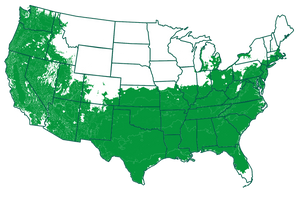* Images shown are of mature plants

Have questions? Talk with our Plant Experts (800) 973-8959
Save 25% on $200+ with code FALL25.
Questions? Call our plant experts: (800) 973-8959
The Cold-Climate Pecan Solution
Finally, a pecan tree that thrives where others struggle. The Lakota Pecan Tree shatters the myth that pecans can't grow in northern regions. This cold-hardy powerhouse was specifically developed to withstand harsh winters while delivering impressive nut yields year after year. The Lakota produces medium-sized pecans with thin shells that practically crack themselves, revealing sweet, rich kernels perfect for snacking, baking, or sharing. The tree grows with remarkable vigor, establishing a strong, well-branched framework that supports heavy nut loads without breaking or splitting. Unlike standard pecan varieties that take years to mature, Lakota reaches productive maturity faster, meaning you'll enjoy substantial harvests sooner. This is the tree for northern gardeners who refuse to compromise on quality or productivity. Plant it once and harvest fresh homegrown pecans for generations to come.
Planting & Care
Seasonal Information: With the proper care trees can be planted during anytime of the year as long as the ground isn’t frozen. However, it is best to plant in the early spring or early fall. This will allow your trees to get rooted into the ground before the stress of hot summer weather or cold winter temperatures set in. If you plant in the fall, plant six weeks before the first frost and if you plant in the spring, wait until six weeks after the final frost. If you plant in the summer, make sure that your trees get enough water.
Selecting a location: When choosing a place to plant your pecan trees remember that they grow best in full sunlight. These trees can tolerate partial shade, but will need at least six hours of sunlight a day in order to flourish. Avoid planting your pecan trees in an area that’s prone to flooding or that collects standing water. Pecan trees can grow quite large, so give them enough space to reach their mature size and avoid planting them under power lines or too close to your home.
Planting Directions:
1) Once you have the perfect planting location scouted out dig a hole that’s just as deep as the root ball, and three times as wide.
2) Take a pitch fork or shovel and use it to loosen the soil around the sides of the hole. Remove any debris like grass, dirt clumps, or rocks from inside of the hole.
3) Place your tree in the hole and make sure that its level with the surrounding ground and standing straight upwards a 90 degree angle.
4) Next back fill your hole and gently tamp the soil down to prevent air pockets from forming.
5) Once the planting process is complete give your tree a long drink of water and mulch around the tree to conserve soil moisture.
Watering: Pecan trees are often thirsty ones. Make sure to keep your soil moist, but not over saturated. Check on the soil every few days, when the top soil feels like it’s starting to dry out give your tree a slow, long drink of water by holding a hose at its base and counting to 20 or 30 seconds.
Fertilization: Pecan trees should be fertilized once a year annually in the early spring. Use a well-balanced, all natural, organic fertilizer like formula 10-10-10. Water your tree thoroughly after fertilizing.
Weed Control: If weeds grow under your tree’s canopy be sure to remove them by taking a firm grip on them and then pulling them upwards out of the ground in a twisting motion. To prevent weeds from growing under your tree spread a 3 to 4 inch thick layer of mulch around the trunk. The mulch will prevent weeds from growing and it will also help the soil retain moisture.
Pruning: It is best to prune your Pecan trees in the early spring, or the early fall. You will need a sharp and sterile pair of loppers or hand pruners. Look at your tree and make a plan before pruning, map out what and where you would like to prune. Remember you can always prune more later and you don’t want to over prune. Remove any dead, diseased, broken, rubbing, or crossing ranches. Make your cuts at a 45 degree angle facing upwards to promote new growth. If a branch is infected cut it back about 6 inches past the infected area.
Pollination: Pecan trees are partially self-fertile. They have both female and male blooms on a single tree, but the male and female flowers open at different times which makes the spreading of pollen a little difficult. You’ll have a much higher yield of crops if you have two or more different pecan varieties.
Shipping Details
Estimated Shipping Time: Most orders ship immediately. As noted on the website, some items are seasonal, and may only ship in spring or fall. Once your order is shipped, you'll receive an email with a tracking number.
| Amount of Order | Shipping Charge |
|---|---|
| Less than $49 | $19.95 |
| $49 + | FREE SHIPPING! |
Product Details
| Mature Height: | 100 ft. |
| Mature Width: | 100 ft. |
| Sunlight: | Full Sun |
| Growth Rate: | Moderate Growing |
| Harvest Time: | October |
| Botanical Name: | Carya illinoinensis 'Lakota' |
| Does Not Ship To: | AK, AZ, CA, HI, NM, TX |
| Grows Well In Zones: | 6-9 outdoors |
| Your Growing Zone: | # |







